Moka Coffee Pot: How to Brew Bold, Rich Espresso at Home
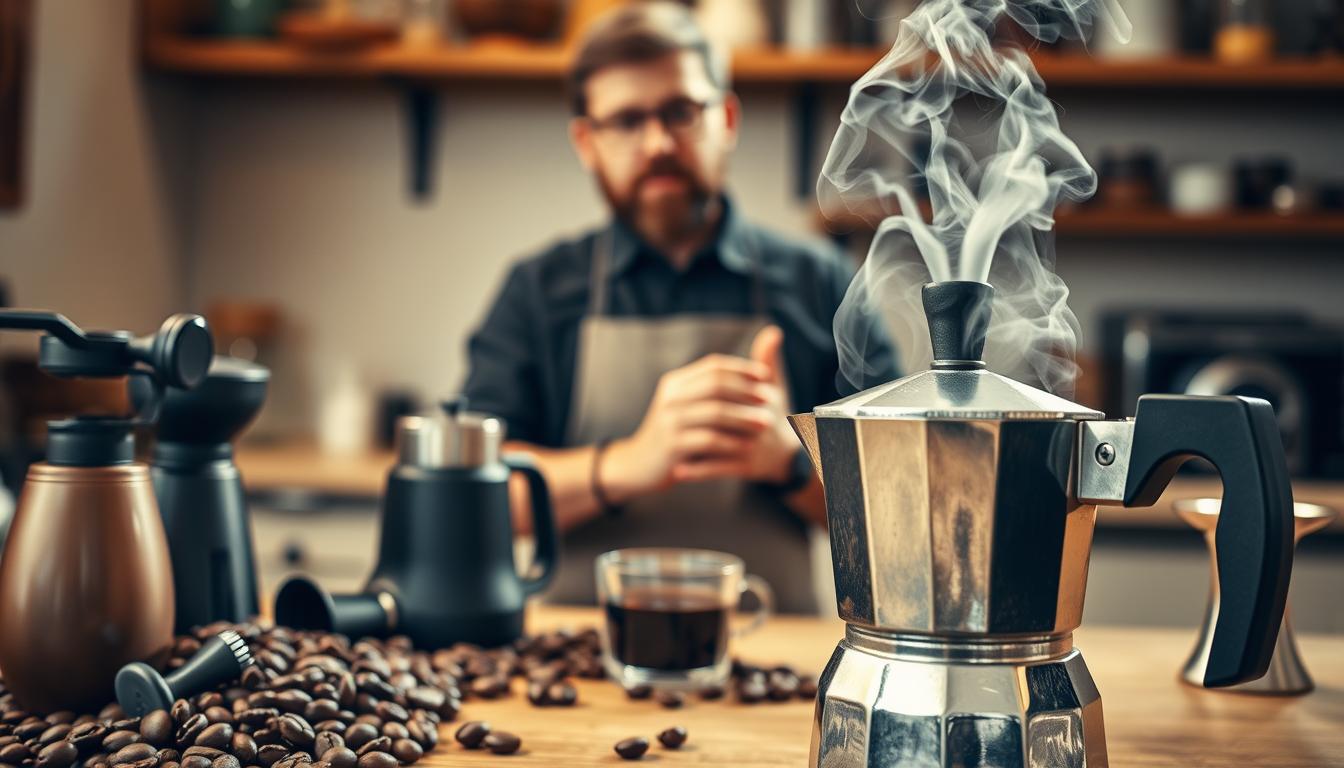
Affiliate Disclosure: As an Amazon Associate, I earn from qualifying purchases. This post may also contain other affiliate links, meaning I may earn a small commission if you buy through them, at no extra cost to you. Your support helps keep this site running and allows me to continue sharing great content. Thank you!
Imagine waking up to the aroma of rich, velvety coffee bubbling on the stovetop, the sound of tradition and craftsmanship in a single brew. That’s the magic of the Moka pot, a time-honored brewing method beloved by espresso enthusiasts worldwide.
This small but mighty coffee maker has been a staple in Italian households for decades, producing bold, espresso-like coffee without the need for expensive machines or high-pressure systems. Whether you’re a seasoned coffee lover or a newcomer looking to upgrade your home brewing game, mastering the Moka coffee pot can open up a world of intense, flavorful coffee.
What This Guide Covers
- What a Moka pot is and how it works
- Choosing the right size and material for your brewing needs
- A step-by-step brewing guide to achieve perfect results every time
- Troubleshooting common issues and pro tips for enhancing flavor
- How the Moka pot compares to other brewing methods
If you’ve ever wondered how to get café-quality coffee at home without an espresso machine, this guide is for you! Let’s dive into the history, technique, and best practices of brewing with a Moka coffee pot.
What Is a Moka Coffee Pot?
The Moka coffee pot, often called a stovetop espresso maker, is a classic brewing device that uses steam pressure to create rich, full-bodied coffee.
Invented in 1933 by Alfonso Bialetti, an Italian engineer, the Moka pot revolutionized home espresso brewing by offering a small, easy-to-use device that could replicate espresso-like coffee without the need for bulky machines. Today, the Moka pot remains a beloved brewing method in Italy and beyond, offering a bold and intense coffee experience with minimal equipment.
How a Moka Pot Works
At first glance, the Moka pot may look like a simple metal coffee maker, but its design is brilliantly engineered to harness the power of steam pressure. It consists of three main chambers:
- Bottom Chamber – Holds water, which is heated to create steam.
- Filter Basket – Contains finely ground coffee that the steam passes through.
- Top Chamber – Collects the brewed coffee after the steam has pushed through the grounds.
The Brewing Process: As the water in the bottom chamber heats up, steam pressure builds, forcing the hot water through the coffee grounds in the filter basket. The extracted coffee then rises into the top chamber, ready to be poured and enjoyed.
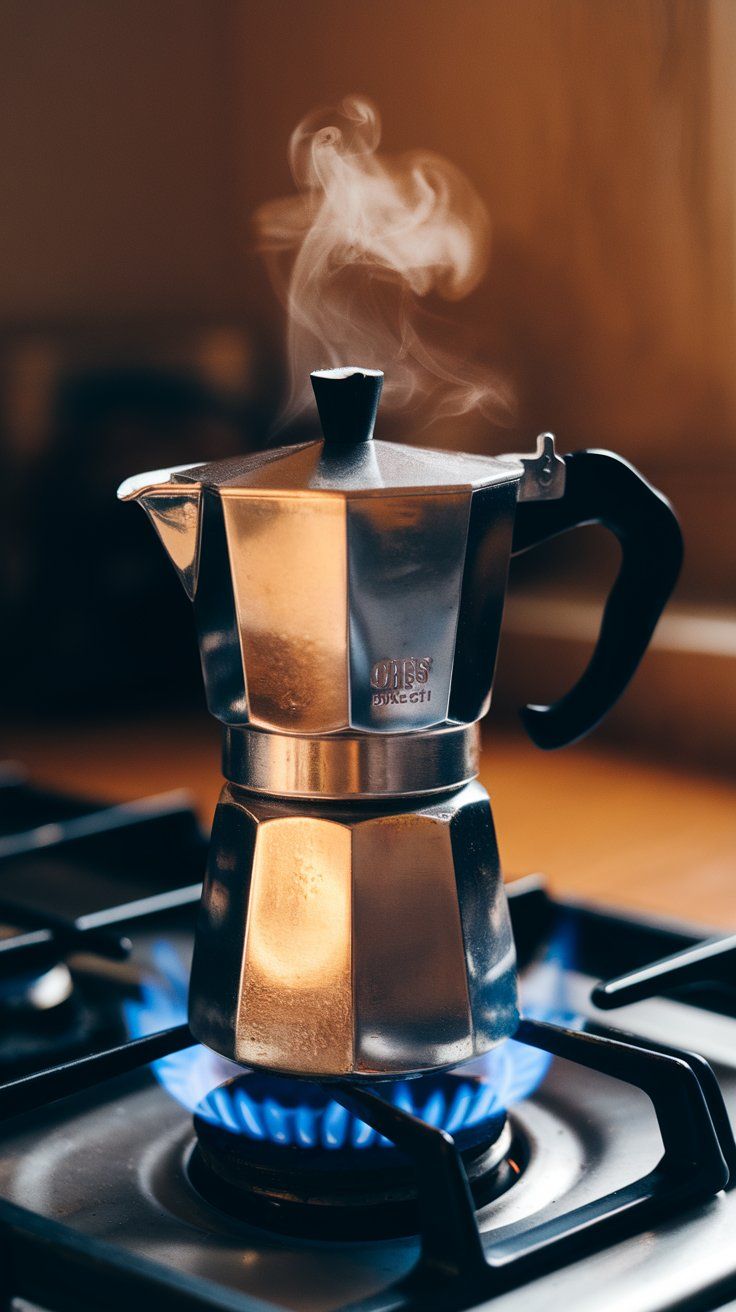
Why Is the Moka Pot So Popular?
The Moka pot is more than just a coffee maker; it’s a symbol of tradition, simplicity, and craftsmanship. Here’s why coffee lovers swear by it:
- Affordable & Accessible – No need for expensive machines, Moka pots range from $20 to $80.
- Rich, Espresso-Like Flavor – Produces bold, concentrated coffee with a thick body.
- No Electricity Required – Perfect for camping, traveling, or minimalist kitchens.
- Long-Lasting Durability – With proper care, a Moka pot can last for decades.
- Customizable Brews – You control the grind size, coffee-to-water ratio, and brewing time to fine-tune your flavor.
Choosing the Right Moka Pot: Size, Material & Brands
Not all Moka pots are the same. While the design remains unchanged, modern variations offer different materials, sizes, and brands to suit different preferences.
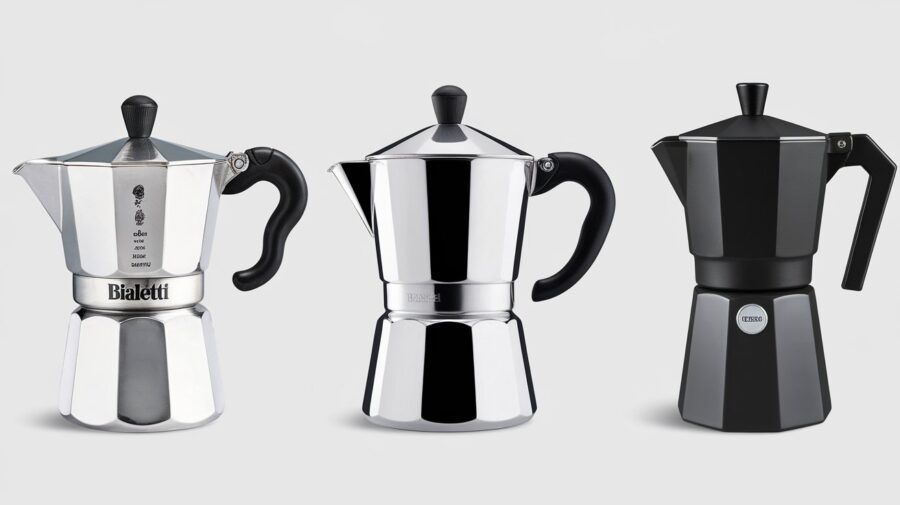
1. Choosing the Right Size
Moka pots come in different sizes, measured in espresso cup servings rather than standard coffee cups.
- 1-cup Moka pot – Ideal for solo drinkers who prefer single servings.
- 3-cup Moka pot – A popular choice for individuals who drink small amounts of strong coffee.
- 6-cup Moka pot – Great for two to three people or those who enjoy multiple cups.
- 9-cup Moka pot – Best for households where several people drink coffee.
- 12-cup Moka pot – Suitable for large families or entertaining guests.
A common mistake is buying a larger Moka pot and brewing smaller quantities, which often leads to poor extraction. Always brew at full capacity for the best flavor.
2. Aluminum vs. Stainless Steel: Which Material Is Best?
Moka pots are typically made from either aluminum or stainless steel, each with distinct benefits.
Aluminum
- Traditional and lightweight.
- Heats quickly, making it energy-efficient.
- Affordable and widely available.
- Requires regular maintenance to prevent oxidation.
Stainless Steel
- More durable and resistant to corrosion.
- Compatible with induction stovetops.
- Does not retain flavors, making it ideal for those who switch between coffee blends.
- Usually more expensive than aluminum models.
3. Best Moka Pot Brands to Consider
If you’re looking for a quality Moka pot, consider these trusted brands:
- Bialetti – The original Moka pot brand, known for its traditional design and reliability.
- Grosche – Offers modern, stylish Moka pots with a focus on sustainability.
- De’Longhi – Produces high-end stainless steel Moka pots with a sleek design.
- Alessi – Features premium Moka pots with a designer aesthetic.
- Cuisinox – Known for durable, high-quality stainless steel models.
Step-by-Step Guide: How to Brew Coffee With a Moka Pot
Brewing coffee with a Moka pot may seem straightforward, but a few key techniques can make the difference between a rich, well-balanced cup and a bitter, over-extracted brew. Follow this step-by-step guide to achieve the best results.
Want a visual guide to brewing with a Moka pot? Watch this short video for a step-by-step demonstration of how to make rich, espresso-style coffee using a stovetop Moka pot. Once you’ve watched, follow the steps below to perfect your technique.
Now that you’ve seen the Moka pot in action, let’s break it down step by step so you can brew a perfect cup every time.
1. Prepare Your Coffee and Water
- Use freshly roasted coffee beans for the best flavor.
- Grind your coffee to a medium-fine consistency, slightly coarser than espresso but finer than drip coffee.
- Fill the bottom chamber with filtered water up to, but not above, the safety valve.
2. Fill the Coffee Basket
- Add ground coffee to the filter basket, leveling it off without pressing down.
- Avoid tamping. Moka pots rely on steam pressure, and compressing the grounds can block the flow.
3. Assemble the Moka Pot
- Place the filter basket into the bottom chamber.
- Screw on the top chamber securely, ensuring a tight seal but without over-tightening.
4. Heat the Moka Pot on the Stovetop
- Set the Moka pot on medium-low heat to allow a slow and even extraction.
- Keep the lid open to monitor the brewing process.
5. Watch for the “Gurgle” Sound
- As the water heats up, coffee will start bubbling into the upper chamber.
- When the brewing slows down and you hear a gurgling sound, remove the pot from the heat immediately to prevent over-extraction.
6. Cool the Bottom Chamber (Optional Pro Tip)
- Quickly running the bottom chamber under cold water stops the extraction instantly, preserving the optimal flavor.
7. Serve and Enjoy
- Pour the freshly brewed coffee into cups and enjoy it black or add steamed milk for variations like a caffè latte or café con leche.
Troubleshooting: Common Moka Pot Mistakes & Fixes
Even with the right technique, brewing with a Moka pot can sometimes lead to unexpected results. If your coffee isn’t turning out as expected, here’s how to fix common issues and improve your brew.
1. Coffee Tastes Burnt or Bitter
- Possible Causes:
- The heat was too high, causing over-extraction.
- Brewed for too long before removing from the heat.
- Using dark roast beans that are already very bitter.
- Fix:
- Brew on medium-low heat to slow extraction.
- Remove from heat as soon as the coffee starts sputtering.
- Try a medium or medium-dark roast for a smoother flavor.
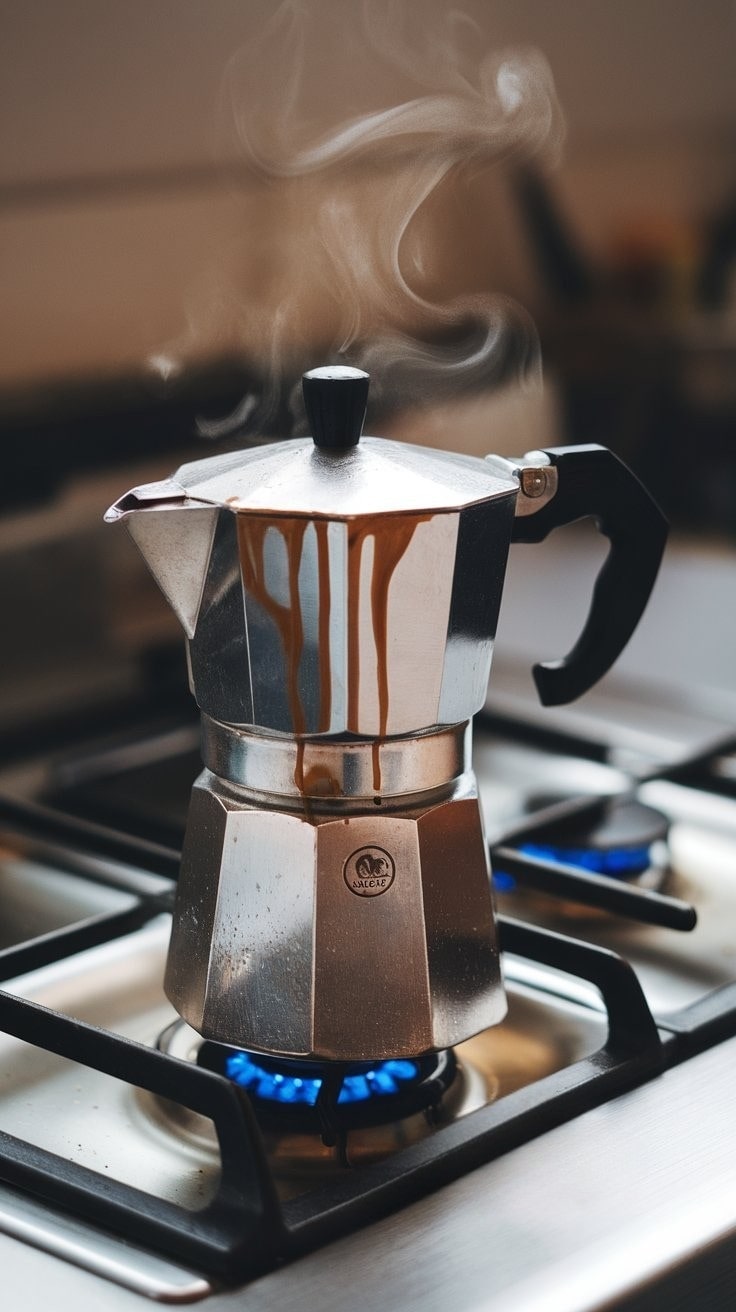
2. Coffee Is Too Weak or Watery
- Possible Causes:
- Grind size is too coarse, resulting in under-extraction.
- Not enough coffee is used in the filter basket.
- The water level is too high or too low in the bottom chamber.
- Fix:
- Use a medium-fine grind, similar to table salt.
- Fill the coffee basket fully, but without pressing down.
- Ensure water is filled just below the safety valve.
3. No Coffee Is Coming Out
- Possible Causes:
- Coffee grounds are packed too tightly, blocking the flow.
- The safety valve is clogged.
- Grind size is too fine, restricting water movement.
- Fix:
- Loosen the grounds; do not tamp them down.
- Clean the safety valve regularly to prevent blockages.
- Adjust to a slightly coarser grind.
4. Metallic or Off-Taste in the Coffee
- Possible Causes:
- A new Moka pot needs seasoning before its first use.
- The pot hasn’t been cleaned properly after previous brews.
- Hard water mineral buildup is affecting the taste.
- Fix:
- Season a new Moka pot by brewing a few batches without drinking the coffee.
- Clean the Moka pot thoroughly after each use, avoiding dish soap on aluminum models.
- Use filtered or softened water to improve flavor and prevent buildup.
5. Coffee Brews Too Quickly or Too Slowly
- Possible Causes:
- If it’s too fast, the grind is too coarse, or the heat is too high.
- If it is too slow, the grind is too fine, or the filter is clogged.
- Fix:
- Adjust grind size to a medium-fine consistency.
- Ensure the filter and safety valve are clean and unblocked.
- Use steady, moderate heat; too high will rush the brew, too low may cause staling.
Enhancing Your Moka Pot Brew: Pro Tips & Variations
Once you’ve mastered the basics of brewing with a Moka pot, small adjustments can help refine the flavor and elevate your coffee experience. From ingredient tweaks to creative variations, here’s how to get the most out of your Moka pot.
1. Optimize Your Coffee Beans and Grind
- Use freshly roasted beans to enhance aroma and flavor. Coffee loses freshness quickly, so aim to brew within two weeks of roasting.
- Choose a medium-dark roast for a rich, balanced flavor. Light roasts tend to taste too acidic, while very dark roasts can turn overly bitter.
- Grind coffee to a medium-fine consistency, similar to table salt. Too fine, and your coffee may become overly strong or clog the filter; too coarse, and it will taste weak.
2. Improve Water Quality for a Better Brew
- Use filtered or spring water instead of tap water, which can contain minerals that impact taste.
- If your water is too hard, mineral buildup may affect the Moka pot’s performance and leave an unpleasant aftertaste. Consider using a water filter or softener.
3. Experiment With Brewing Ratios
- The standard Moka pot coffee-to-water ratio is about 1:7 (one gram of coffee for every seven grams of water).
- For a stronger coffee, increase the coffee dose slightly, but never overfill the basket.
- If the coffee is too intense, dilute it with a splash of hot water to create a Caffè Americano-style drink.
4. Try Different Milk-Based Variations
Moka pot coffee is incredibly versatile and can be used as a base for different milk-based drinks:
- Cuban Café con Leche – Add a small amount of sugar directly into the filter basket before brewing, then mix the brewed coffee with warm milk.
- Italian Caffè Latte – Froth milk separately and pour it over Moka coffee for a smooth, creamy texture.
- Moka Pot Mocha – Add a teaspoon of cocoa powder to the coffee grounds before brewing, then mix with steamed milk for a rich chocolatey twist.

5. Maintain Your Moka Pot for Long-Lasting Performance
- Clean the Moka pot after every use to prevent old coffee oils from affecting flavor.
- Avoid using dish soap on aluminum models; simply rinse with warm water and dry thoroughly.
- Occasionally, deep-clean the filter and safety valve to remove buildup and ensure proper pressure flow.
Moka Pot vs. Other Brewing Methods: How Does It Compare?
The Moka pot is often considered a middle ground between espresso and traditional brewed coffee. It produces a strong, concentrated cup without the complexity or cost of an espresso machine. But how does it hold up against other popular brewing methods?
Before diving into the key drawbacks of the Moka pot compared to other methods, here’s a quick side-by-side comparison in the table below of how it stacks up in terms of time, pressure, grind size, and flavor.
| Feature | Moka Pot | Espresso Machine | French Press | Pour-Over |
| Brewing Time | 5-7 min | 25-30 sec | 4 min | 3-4 min |
| Pressure Used | 1-2 bars | 9 bars | None | None |
| Grind Size | Medium-fine | Fine | Coarse | Medium |
| Flavor Profile | Bold, concentrated | Rich, creamy, intense | Heavy-bodied, smooth | Light, delicate, floral |
| Mouthfeel | Clean, no sediment | Thick crema | Thick, with coffee oils | Very clean, bright acidity |
| Skill Level | Easy | Advanced | Beginner | Intermediate |
| Cost | $20-$80 | $300-$1000+ | $20-$50 | $30-$100 |
Despite offering a strong and convenient brewing experience, the Moka pot has its limitations compared to these methods. Let’s take a look at where it falls short in comparison.
What the Moka Pot Lacks Compared to Other Brewing Methods
- Moka Pot vs. Espresso Machine
- No true espresso crema – Unlike an espresso machine, the Moka pot doesn’t reach 9 bars of pressure, meaning you won’t get that thick, velvety crema on top.
- Less control over extraction – Espresso machines allow you to adjust pressure, temperature, and extraction time; the Moka pot has limited customization.
- Not as fast – While easier to use, a Moka pot still takes 5-7 minutes, whereas an espresso machine delivers a shot in under 30 seconds.
- Moka Pot vs. French Press
- More acidic and intense – The Moka pot produces a stronger, sharper brew, while the French press gives a smoother, oil-rich cup.
- Less forgiving on grind size – A Moka pot requires a precise grind to avoid clogging or over-extraction, whereas a French press is much more flexible.
- More maintenance – Moka pots must be cleaned regularly to prevent buildup, while a French press is simpler to rinse and reuse.
- Moka Pot vs. Pour-Over (V60, Chemex, etc.)
- Lacks clarity and aroma – Pour-over methods highlight delicate, floral, and tea-like flavors, while Moka pot coffee is bold and heavy.
- It can taste bitter if overheated. Pour-over offers more temperature control, whereas Moka pot brewing at too high a heat easily leads to bitterness.
- It is not ideal for light roasts. If you love bright, acidic light roasts, pour-over brewing brings out those nuances better than a Moka pot.
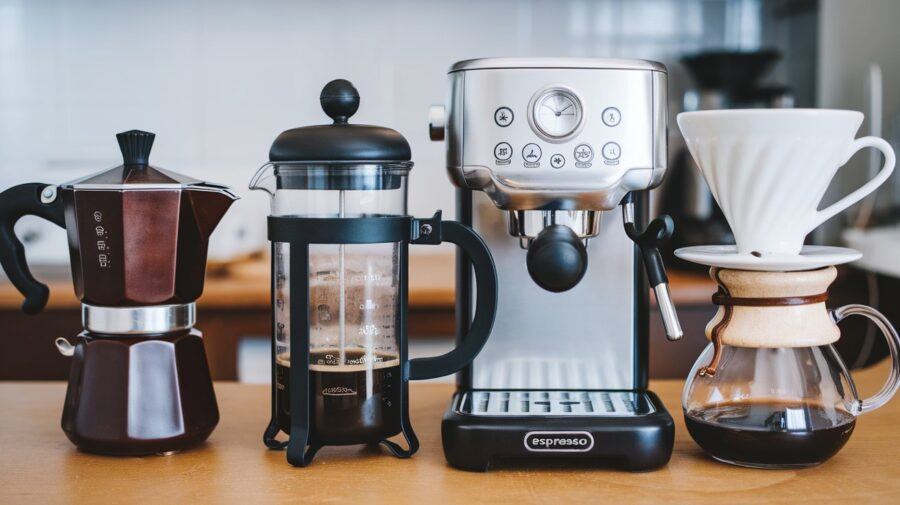
Final Thoughts – Why the Moka Pot Is a Must-Have
The Moka pot is more than just a coffee maker; it’s a timeless brewing method that combines tradition, convenience, and affordability. Whether you’re a coffee enthusiast looking for a strong, espresso-like brew or someone who enjoys the ritual of stovetop brewing, the Moka pot is a worthy addition to any kitchen.
Why You Should Own a Moka Pot
- Affordable & Durable – A one-time investment that lasts for years with proper care.
- Espresso-Style Coffee Without the Cost – Delivers a bold, rich cup without needing an expensive espresso machine.
- Versatile & Portable – Works on most stovetops, requires no electricity, and is perfect for home, travel, and camping.
- Easy to Master – Simple to use with a quick learning curve, making it accessible for beginners and coffee lovers alike.
- Customizable Brewing Experience – Experiment with grind size, brew ratios, and variations like caffè latte or Cuban café con leche to suit your taste.
A Moka pot brings the charm of Italian coffee culture into your home, giving you the ability to brew a delicious, strong coffee with just a stovetop and a little practice. If you’ve brewed with a Moka pot before, what’s your favorite technique or variation? Or if you’re new to it, do you have any questions? Drop a comment below. I’d love to hear your thoughts!
Save this guide for later so you can perfect your Moka pot brewing!

I help coffee lovers experience the rich stories, origins, and luxury of high-end coffee. At Aroma Expeditions, I share my passion for sustainable sourcing, ethical beans, and the art behind every pour.
Let’s turn your daily brew into an adventure worth savoring.
This article really opened my eyes to the world of Moka coffee pots! I had never heard of them before and didn’t even know where to start.
Do you think using a Moka pot makes a significant difference in taste compared to regular drip coffee makers?
Also, do you have any tips for beginners on how to get the best results without making it too strong or bitter?
I’m excited to try it for my husband and see how it compares to my usual brewing methods!
Angela 🙂
I love that this article introduced you to the Moka pot! It’s such a classic and rewarding way to brew coffee, and I think you’ll have fun experimenting with it.
To answer your question—Moka pot coffee vs. drip coffee is quite different! A drip coffee maker produces a lighter, more filtered brew, whereas a Moka pot creates a richer, more concentrated coffee, similar to espresso but not as intense. If you enjoy bold flavors with a bit more depth, you’ll likely love the difference!
For beginner-friendly tips to keep the coffee from becoming too strong or bitter:
✔ Use medium-fine coffee grounds – Too fine can lead to over-extraction and bitterness, while too coarse may make it weak.
✔ Preheat your water – Adding preheated water instead of cold water reduces the chance of overcooking the coffee.
✔ Keep the heat low – A slow, controlled brew brings out the best flavors without burning the coffee.
✔ Remove it from heat early – As soon as you hear the hissing sound, take the Moka pot off the heat to prevent over-extraction.
That’s so sweet that you’re trying this for your husband! How does he usually take his coffee? If he enjoys stronger brews like espresso or French press, he might love Moka pot coffee. If he prefers lighter coffee, you can dilute it with hot water (like an Americano) or add steamed milk for a Moka pot latte.
Can’t wait to hear how your first brew turns out! Happy brewing!
Wow, your blog provides a fantastic guide for anyone looking to learn about moka pot brewing! I love how it covers the essentials, from the history and science behind the moka pot to detailed troubleshooting tips. It’s clear that this brewing method isn’t just about making coffee—it’s about embracing tradition and craftsmanship.
I especially appreciate the tips on adjusting grind size and water quality to optimize the brew.
The step-by-step guide is super helpful for anyone new to the moka pot, and the troubleshooting section is a lifesaver for avoiding common mistakes. This is definitely going on my coffee brewing list—I can’t wait to try some new variations, like the Cuban Café con Leche!
I love your enthusiasm for Moka pot brewing! It really is more than just making coffee—it’s about embracing tradition, technique, and craftsmanship, and it’s great to hear that the guide gave you useful insights. Fine-tuning grind size and water quality can make all the difference in getting that perfect cup!
Trying Cuban Café con Leche sounds like a fantastic idea! If you enjoy bold, rich coffee with creamy sweetness, it’s definitely a great variation to experiment with. A small tip: using evaporated milk instead of regular milk gives it an extra depth of flavor. You might also want to try a Moka pot cortado—a slightly stronger take with equal parts coffee and steamed milk.
I’d love to hear how your brewing experience goes! Are there any other Moka pot variations you’re excited to try?
Happy brewing!
There’s nothing better than starting the day with a great cup of coffee! This is the first time I’ve heard of a Moka pot, and after reading this, we’ve decided to get one and try it.
We’ve been using a pour-over, but it looks like the Moka pot will give us a much richer cup.
Thanks for a great article—mornings will soon be even better!
That’s exciting—you’re going to love the Moka pot experience! It’s such a great way to enhance your morning coffee ritual with a richer, more intense brew. Since you’re coming from pour-over coffee, you’ll definitely notice a difference in body and strength—Moka pot coffee is more concentrated, almost like a small, bold espresso.
If you’re looking for a smooth transition, you might want to start by diluting it slightly with hot water (similar to an Americano) or adding a splash of milk to balance out the intensity. Once you get used to the depth of flavor, you can experiment with different grind sizes or coffee blends to find the perfect cup for you.
Can’t wait to hear how your first Moka pot brew turns out! Let me know if you have any questions along the way.